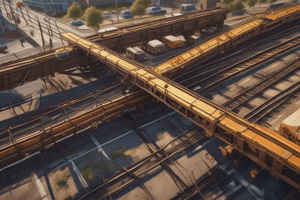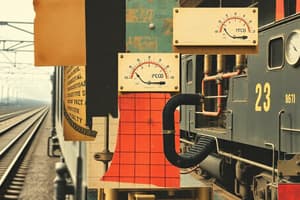Podcast
Questions and Answers
What does a yellow sign with a black letter 'RR' and 'X' symbol indicate?
What does a yellow sign with a black letter 'RR' and 'X' symbol indicate?
- Railroad Crossing (correct)
- School Zone
- Pedestrian Crossing
- Stop Sign
Which vehicles must stop at all railroad crossings?
Which vehicles must stop at all railroad crossings?
- Passenger Cars
- Motorcycles
- Trucks
- School Buses (correct)
What should you do when approaching a railroad crossing that does not have signals?
What should you do when approaching a railroad crossing that does not have signals?
Slow down and be prepared to stop.
When can you proceed across a set of railroad tracks if traffic prevents you from crossing completely?
When can you proceed across a set of railroad tracks if traffic prevents you from crossing completely?
What must you do if an approaching train is near enough to be a danger?
What must you do if an approaching train is near enough to be a danger?
You may drive around or under a gate that is being lowered or raised at a railroad crossing.
You may drive around or under a gate that is being lowered or raised at a railroad crossing.
Why is driving on an expressway different from driving on an ordinary street?
Why is driving on an expressway different from driving on an ordinary street?
Why is night driving considered dangerous?
Why is night driving considered dangerous?
What applies to all driving emergency situations?
What applies to all driving emergency situations?
What should you do when you leave an expressway and start driving on an ordinary highway?
What should you do when you leave an expressway and start driving on an ordinary highway?
What should you do if your car starts to skid on a slippery road?
What should you do if your car starts to skid on a slippery road?
What is the purpose of expressway entrance lanes (acceleration lanes)?
What is the purpose of expressway entrance lanes (acceleration lanes)?
When driving in heavy fog during daylight hours, you should drive with your:
When driving in heavy fog during daylight hours, you should drive with your:
When driving at night, what is the most important thing to remember?
When driving at night, what is the most important thing to remember?
What should you do if you drive past your exit on an expressway?
What should you do if you drive past your exit on an expressway?
When getting ready to leave an expressway, when should you begin to use your turn signal?
When getting ready to leave an expressway, when should you begin to use your turn signal?
If a tire blows out, what is the proper action to take?
If a tire blows out, what is the proper action to take?
What is the best action to take when attempting to stop on a slippery road?
What is the best action to take when attempting to stop on a slippery road?
If your right wheels run onto a soft shoulder, what is the best way to get back on the highway?
If your right wheels run onto a soft shoulder, what is the best way to get back on the highway?
What should you do if your brake pedal suddenly sinks to the floor?
What should you do if your brake pedal suddenly sinks to the floor?
How can you reduce glare from the headlights of an approaching car while driving at night?
How can you reduce glare from the headlights of an approaching car while driving at night?
When entering a highway with a very short entrance lane, what is the safest way to enter the flow of traffic?
When entering a highway with a very short entrance lane, what is the safest way to enter the flow of traffic?
Study Notes
Railroad Crossings
- A yellow sign with black letters "RR" and an "X" symbol indicates a railroad crossing.
- All school buses and passenger buses carrying passengers must stop at railroad crossings.
- When approaching a railroad crossing without signals, slow down and prepare to stop.
- Only cross tracks if there is space for your vehicle on the other side, even if traffic is present.
- Do not attempt to cross tracks if an approaching train poses danger until it has completely passed.
- Driving around or under a gate during lowering or raising is prohibited.
Driving on Expressways
- Expressway driving demands quicker thinking and effective vehicle handling compared to ordinary streets.
- Night driving reduces visibility and increases danger due to shorter sight distances.
- In any driving emergency, prioritize thinking before acting to make informed decisions.
- After leaving an expressway, monitor the speedometer to adhere to lower highway speed limits.
- Use the turn signal 100 feet prior to exiting an expressway.
Handling Vehicle Emergencies
- If your car skids on a slippery road, steer in the direction you want the front wheels to go.
- Expressway entrance lanes allow drivers to reach appropriate speeds for merging with traffic.
- During daylight in heavy fog, use low beam headlights for better visibility.
- When driving at night, ensure your speed is within the range illuminated by your headlights.
Brake and Tire Issues
- If you miss your exit on an expressway, continue to the next exit rather than reversing.
- In the event of a tire blowout, grip the steering wheel firmly and ease off the gas pedal.
- For safe stopping on slippery roads, apply brakes steadily and gradually.
- If your vehicle veers onto a soft shoulder, ease off the gas and brake gently to regain control.
- Should the brake pedal sink to the floor, pump it to attempt to restore brake pressure.
Dealing with Glare and Traffic Merging
- To minimize glare from oncoming headlights while driving at night, focus on the lower right side of your lane.
- Upon entering a highway with a short entrance lane, wait for a significant gap before accelerating to merge safely.
Studying That Suits You
Use AI to generate personalized quizzes and flashcards to suit your learning preferences.
Description
This quiz covers essential safety rules for railroad crossings and expressway driving. Learn about the signs, regulations, and emergency procedures required for safe travel on these roads. Test your knowledge to ensure safe driving habits on highways and around train tracks.




